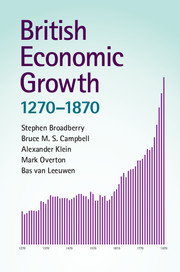Book contents
- Frontmatter
- Contents
- List of Tables
- List of Figures
- List of Appendices
- Preface and acknowledgements
- List of Weights, measures and money
- Prologue: Historical national income accounting
- Part I Measuring economic growth
- 1 Population
- 2 Agricultural land use
- 3 Agricultural production
- 4 Industrial and service-sector production
- 5 GDP and GDP per head
- Part II Analysing economic growth
- Bibliography
- Index
4 - Industrial and service-sector production
Published online by Cambridge University Press: 05 January 2015
- Frontmatter
- Contents
- List of Tables
- List of Figures
- List of Appendices
- Preface and acknowledgements
- List of Weights, measures and money
- Prologue: Historical national income accounting
- Part I Measuring economic growth
- 1 Population
- 2 Agricultural land use
- 3 Agricultural production
- 4 Industrial and service-sector production
- 5 GDP and GDP per head
- Part II Analysing economic growth
- Bibliography
- Index
Summary
Introduction
In 1270 the agricultural sector dominated economic output, dwarfing the industrial and service sectors. By 1870, notwithstanding an eightfold expansion of agricultural output, this situation had been reversed and industry and services were the fastest-growing and largest sectors. The progress of British industry has been closely scrutinised from 1700 but less so in earlier centuries notwithstanding that the roots of Britain’s industrial rise extend back much earlier than the conventional starting date of the industrial revolution in the mid-eighteenth century. The service sector, which already by the mid-nineteenth century had overtaken industry and emerged as the dominant sector within the economy, has received far less attention and awaits systematic investigation from the bottom up. This unevenness of treatment has required adoption of a range of approaches in order to derive valid estimates of industrial and service-sector output and thereby chart these profound changes in the structure of economic activity and volumes of industrial and service-sector output across the 600 years under investigation.
Industrial output
From 1700 industry is the one economic sector for which annual data have previously been gathered and analysed on a national scale. Full use has therefore been made of these existing estimates. Pioneering work by Hoffmann (1955) inadvertently overstated the growth rate of industrial output during the industrial revolution as a result of the weighting procedures applied to a dataset which covered only 56 per cent of industrial output. As Harley (1982) and Crafts (1985) separately point out, the problem is that a few industries, most notably cotton and iron, grew more rapidly than the rest of manufacturing, and these atypical industries bulk disproportionately large in Hoffmann’s output series. By extrapolating total industrial output from that series he effectively doubled the weights of the most dynamic industries. Harley (1982) and Crafts and others (1989) have overcome this problem by limiting the weights applied to cotton and iron and increasing those applied to other industries, thereby arriving at lower estimates of total industrial output growth.
- Type
- Chapter
- Information
- British Economic Growth, 1270–1870 , pp. 130 - 186Publisher: Cambridge University PressPrint publication year: 2015

